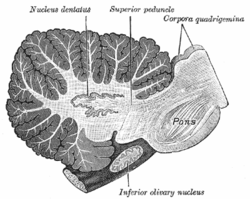- Globose nucleus
-
Brain: Globose nucleus 
Sagittal section through right cerebellar hemisphere. The right olive has also been cut sagitally. (Emboliform nucleus not labeled, but region is visible.) ) Latin nucleus globosus Gray's subject #187 796 NeuroNames hier-686 NeuroLex ID birnlex_1159 The globose nucleus is one of the deep cerebellar nuclei. It is located medial to the emboliform nucleus and lateral to the fastigial nucleus. This nucleus contains primarily large and small multipolar neurons.
The globose nucleus and emboliform nucleus are occasionally referred to collectively as the interposed nucleus.
External links
- http://www.mona.uwi.edu/fpas/courses/physiology/neurophysiology/Cerebellum.htm
- http://www.lib.mcg.edu/edu/eshuphysio/program/section8/8ch6/s8ch6_30.htm
- NIF Search - Globose Nucleus via the Neuroscience Information Framework
This article was originally based on an entry from a public domain edition of Gray's Anatomy. As such, some of the information contained within it may be outdated.
Human brain, rhombencephalon, metencephalon: cerebellum (TA 14.1.07, GA 9.788) Surface anatomy LobesMedial/lateralVermis: anterior (Central lobule, Culmen, Lingula) · posterior (Folium, Tuber, Uvula) · Vallecula of cerebellum
Hemisphere: anterior (Alar central lobule) · posterior (Biventer lobule, Cerebellar tonsil)Grey matter Molecular layer (Stellate cell, Basket cell)
Purkinje cell layer (Purkinje cell, Bergmann glia cell = Golgi epithelial cell)
Granule cell layer (Golgi cell, Granule cell, Unipolar brush cell)
Fibers: Mossy fibers · Climbing fiber · Parallel fiberWhite matter InternalPedunclesInferior (medulla): Dorsal spinocerebellar tract · Olivocerebellar tract · Cuneocerebellar tract · Juxtarestiform body (Vestibulocerebellar tract)
Middle (pons): Pontocerebellar fibers
Superior (midbrain): Ventral spinocerebellar tract · Dentatothalamic tract · Trigeminocerebellar fibers
This anatomy article is a stub. You can help Wikipedia by expanding it.
